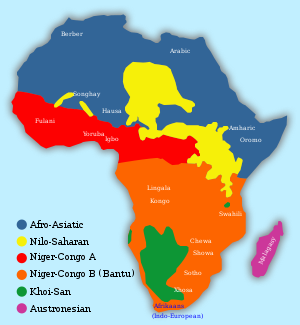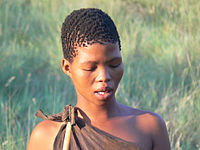Khoisan: Difference between revisions
Kwamikagami (talk | contribs) No edit summary |
No edit summary |
||
| Line 80: | Line 80: | ||
[[hi:खोइसान]] |
[[hi:खोइसान]] |
||
[[it:Khoisan]] |
[[it:Khoisan]] |
||
[[ky:Койсан элдери]] |
|||
[[lt:Koisanai]] |
[[lt:Koisanai]] |
||
[[nl:Khoisan (volk)]] |
[[nl:Khoisan (volk)]] |
||
Revision as of 11:19, 6 March 2012
 33-year-old San tribesman from Namibia | |
| Regions with significant populations | |
|---|---|
| Southern Africa | |
| Languages | |
| Khoisan languages | |
| Religion | |
| Mainly Christian and Animist | |
| Related ethnic groups | |
| perhaps Sandawe |
Khoisan (also spelled Khoesaan, Khoesan or Khoe–San) is a unifying name for two ethnic groups of Southern Africa, who share physical and putative linguistic characteristics distinct from the Bantu majority of the region.[1] Culturally, the Khoisan are divided into the foraging San and the pastoral Khoi. The San include the original inhabitants of Southern Africa before the southward Bantu migrations from Central and East Africa reached their region, which led to Bantu farmers replacing the Khoi and San as the predominant population. Khoi pastoralists apparently arrived in Southern Africa shortly before the Bantu. Over time, some Khoi abandoned pastoralism and adopted the hunter-gatherer economy of the San, likely due to a drying climate, and are now considered San. Similarly, the Bantu Damara later abandoned agriculture and adopted the Khoi economy. Large Khoisan populations remain in several arid areas in the region, notably in the Kalahari Desert.
Terminology
Other terms used to describe the Khoisan people include Bushmen, referring to the San, and Hottentot, referring to the Khoi or Khoe. Khoi derives from the old Nama word for "person", while Khoe is the modern Nama word. "Bushmen" is still being used by some individuals, though considered obsolete by others (the use of "San" is acceptable, despite its origins as a derogatory Khoe term for the Bushmen), while "Hottentot" is generally considered derogatory and is no longer used ("Khoe" should be used instead).[2]
San community representatives declared a preference to be known either by their individual community names (!Xun or ‡Khomani, for example) or collectively as Bushmen, rather than as San or Khoisan. If the Bushmen need to be grouped with the Khoe pastoralist groups, the term Khoe–San is preferred.[2]
History

From the beginning of the Upper Paleolithic period, hunting and gathering cultures known as the Sangoan occupied southern Africa in areas where annual rainfall is less than a metre (1000 mm; 40 in),[3] and today's San and Khoi people resemble the ancient Sangoan skeletal remains. These Late Stone Age people in parts of southern Africa were the ancestors of the Khoisan people who inhabited the Kalahari Desert. Likely due to their region's lack of suitable candidates for domestication, the Khoisan did not have farming or domesticated animals until a few hundred years before then, when they adopted the domesticated cattle and sheep of the Bantu that had spread in advance of the people's actual arrival.[4] The Bantu people, with advanced agriculture and metalworking technology developed in West Africa from at least 2000 BC, outcompeted and intermarried with the Khoisan in the years after contact and became the dominant population of Southeastern Africa before the arrival of the Dutch in 1652.[5]
The evidence of the Khoisan's original presence in South Africa in fact can be seen in the distribution of their languages today, which often show extreme differences in structure and vocabulary despite close proximity, demonstrating a long period of settlement and co-evolution of languages in the same region.[6] In contrast, the languages of Bantu-origin peoples in the region such as the Zulu and Xhosa are all very similar to one another. This indicates a much more recent common ancestry for the first Bantu group that spread and settled across the region.[7] Among their descendants, the Xhosa and Zulu adopted unique Khoisan click consonant and loan words into their respective languages.

After the arrival of the Bantu, the Khoisan and their pastoral or hunter-gatherer ways of life remained predominant west of the Fish River in South Africa and in deserts throughout their region, where the drier climate precluded the growth of Bantu crops suited for warmer and wetter climates. It took the arrival of Mediterranean crops from Europe in the 17th century for the Bantu farmers, and later white Boer farmers, to spread to the rest of the country and begin replacing the Khoisan population.[8] During the colonial era, the Khoisan survived in South Africa, Namibia and Botswana. Today many of the San live in parts of the Kalahari Desert where they are better able to preserve much of their culture and lifestyle.
Against the traditional interpretation that finds a common origin for the Khoi and San, other evidence has suggested that the ancestors of the Khoi peoples (one subset of the Khoisan) are relatively recent pre-Bantu agricultural immigrants to southern Africa, who abandoned agriculture as the climate dried and either joined the San as hunter-gatherers or retained pastoralism to become the Khoikhoi.
Genetic studies
In the 1990s, genomic studies of different peoples around the world found that the Y chromosome of Khoisan men (using samples drawn from several San tribes) share certain patterns of polymorphisms that are distinct from the genomes of all other populations.[9] As the Y chromosome is highly conserved from generation to generation, this type of DNA testing is used by geneticists to determine when different subgroups separated from one another and hence their last common ancestry. The authors of these studies suggested that the Khoisan (actually the San) may have been one of the first populations to differentiate from the most recent common paternal ancestor of all extant humans, the so-called Y-chromosomal Adam by patrilineal descent, estimated to have lived 60,000 to 90,000 years ago.[10] The authors also note that their results should be interpreted as only finding that the Khoisan "preserve ancient lineages", and not that they "stopped evolving" or are an "ancient group", since subsequent changes in their population are in parallel and similar to those of all other human populations.[9]
Various Y-chromosome studies [11][12][13] since confirmed that the Khoisan carry some of the most divergent (oldest) Y-chromosome haplogroups. These haplogroups are specific sub-groups of haplogroups A and B, the two earliest branches on the human Y-chromosome tree.
Similar to findings from Y-Chromosome studies, mitochondrial DNA studies also showed evidence that the Khoe–San people carry high frequencies of the earliest haplogroup branches in the human mitochondrial DNA tree. The most divergent (oldest) mitochondrial haplogroup, L0d, have been identified at its highest frequencies in the southern African Khoe and San groups.[14][11][15][16]
Physical appearance

Physically the Khoisan, with their short frames (149–163 cm/4'9-5'4;), copper brown skin, tightly coiled "peppercorn" hair, high cheekbones, and epicanthic eye folds are quite distinct from the darker-skinned peoples who constitute the majority of Africa's population, though both population are usually dolichocephalic (Huxley, 1870). They have moderately long legs and longer abdominal muscles, traits that sharply distinguish them from surrounding Pygmy and Bantu populations having muscles with short bellies and long tendons (Coon 1965). In past ethnography, the Khoisan have been referred to as the Capoid race because they can be visually distinguished from the Congoid Africans of Bantu origin.[17]
In the 19th century, a distinguishing feature of Khoisan women was considered to be their tendency for steatopygia.[18] This belief contributed greatly to the European fascination with the so-called Hottentot Venus.
See also
References
- ^ Barnard, Alan (1992) Hunters and Herders of Southern Africa: A Comparative Ethnography of the Khoisan Peoples. New York; Cambridge: Cambridge University Press, 1992.
- ^ a b Schlebusch C (2010). "Issues raised by use of ethnic-group names in genome study". Nature. 464 (7288): 487. doi:10.1038/464487a.
- ^ Lee, Richard B. (1976), Kalahari Hunter-Gatherers: Studies of the !Kung San and Their Neighbors, Richard B. Lee and Irven DeVore, eds. Cambridge: Harvard University Press
- ^ Diamond, 396.
- ^ Diamond, 394-7.
- ^ Diamond, 384
- ^ Diamond, 384-6.
- ^ Diamond, 397
- ^ a b Schoofs, Mark (April 4, 2000). "Fossils in the Blood". The Body.
- ^ Mayell, Hillary (December 2002). "Documentary Redraws Humans' Family Tree". National Geographic.
- ^ a b Knight, Alec; Underhill, Peter A.; Mortensen, Holly M.; Zhivotovsky, Lev A.; Lin, Alice A.; Henn, Brenna M.; Louis, Dorothy; Ruhlen, Merritt; Mountain, Joanna L. (2003). "African Y chromosome and mtDNA divergence provides insight into the history of click languages". Current Biology. 13 (6): 464–73. doi:10.1016/S0960-9822(03)00130-1. PMID 12646128.
- ^ Hammer MF, Karafet TM, Redd AJ, Jarjanazi H, Santachiara-Benerecetti S, Soodyall H and Zegura SL (2001). "Hierarchical patterns of global human Y-chromosome diversity". Molecular Biology and Evolution. 18 (7): 1189–203. PMID 11420360.
{{cite journal}}: CS1 maint: multiple names: authors list (link) - ^ Naidoo T, Schlebusch CM, Makkan H, Patel P, Mahabeer R, Erasmus JC and Soodyall H (2010). "Development of a single base extension method to resolve Y chromosome haplogroups in sub-Saharan African populations". Investigative Genetics. 1 (1): 6. doi:10.1186/2041-2223-1-6. PMC 2988483. PMID 21092339.
{{cite journal}}: CS1 maint: multiple names: authors list (link) CS1 maint: unflagged free DOI (link) - ^ Chen YS, Olckers A, Schurr TG, Kogelnik AM, Huoponen K and Wallace DC (2000). "mtDNA variation in the South African Kung and Khwe, and their genetic relationships to other African populations". The American Journal of Human Genetics. 66 (4): 1362–83. doi:10.1086/302848. PMC 1288201. PMID 10739760.
{{cite journal}}: CS1 maint: multiple names: authors list (link) - ^ Tishkoff, SA; Gonder, MK; Henn, BM; Mortensen, H; Knight, A; Gignoux, C; Fernandopulle, N; Lema, G; Nyambo, TB (2007). "History of click-speaking populations of Africa inferred from mtDNA and Y chromosome genetic variation" (PDF). Molecular Biology and Evolution. 24 (10): 2180–95. doi:10.1093/molbev/msm155. PMID 17656633.
- ^ Schlebusch CM, Naidoo T and Soodyall H (2009). "SNaPshot minisequencing to resolve mitochondrial macro-haplogroups found in Africa". Electrophoresis. 30 (21): 3657–64. doi:10.1002/elps.200900197. PMID 19810027.
- ^ Moore, Ruth Evolution (Life Nature Library) New York: 1962 Time, Inc. Chapter 8: "The Emergence of Modern Homo Sapiens" p. 173 – First page of picture section "Man and His Genes": The Capoid race is identified as one of the five major races of mankind, along with the Mongoloid, Negroid, Caucasoid, and Australoid races (pictures of a person typical of each race are shown)
- ^ Baker, John R. (1974). The 'Hottentot Venus'. From John R. Baker: Race, Oxford University Press, 1974; Athens, Ga, Foundation for Human Understanding, 1981, pp. 313–319.
Bibliography
- Barnard, Alan (2004) Mutual Aid and the Foraging Mode of Thought: Re-reading Kropotkin on the Khoisan. Social Evolution & History 3/1: 3–21.
- Coon, Carleton: The Living Races of Man (1965)
- Diamond, Jared (1999). Guns, Germs, and Steel. New York: W.W. Norton & Company. ISBN 0-393-31755-2Template:Inconsistent citations
{{cite book}}: CS1 maint: postscript (link). - Hogan, C. Michael (2008) "Makgadikgadi" at Burnham, A. (editor) The Megalithic Portal
- Lee, Richard B. (1979), The !Kung San: Men, Women, and Work in a Foraging Society. Cambridge: Cambridge University Press.
- Smith, Andrew; Malherbe, Candy; Guenther, Mat and Berens, Penny (2000), Bushmen of Southern Africa: Foraging Society in Transition. Athens: Ohio University Press. ISBN 0-8214-1341-4
- Thomas, Elizabeth Marshall (1958, 1989) The Harmless People.
- Thomas, Elizabeth Marshall (2006). The Old Way: A Story of the First People.
External links
- The Khoisan
- Home of the Southern African San
- "Khoesan languages" from Web Resources for African Languages
